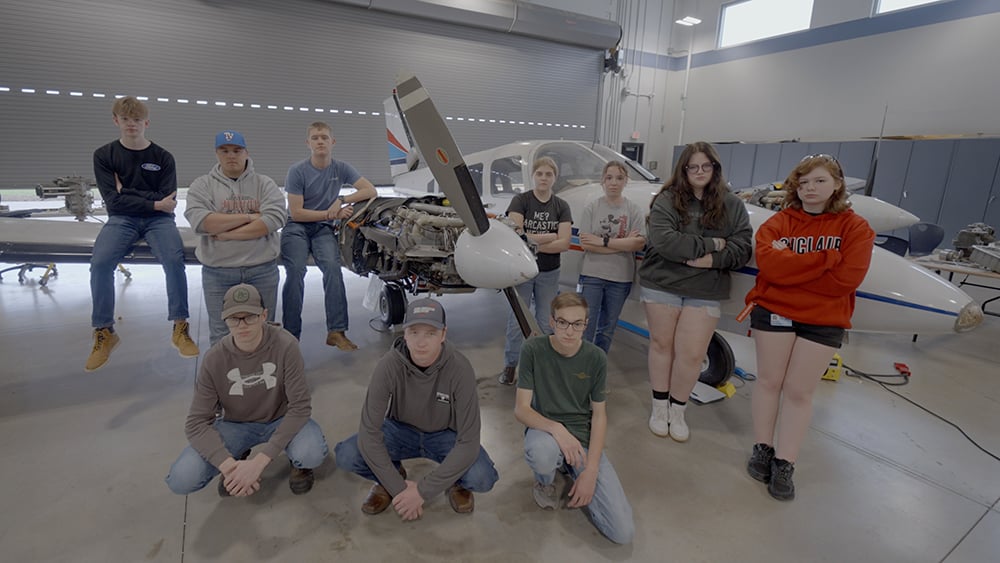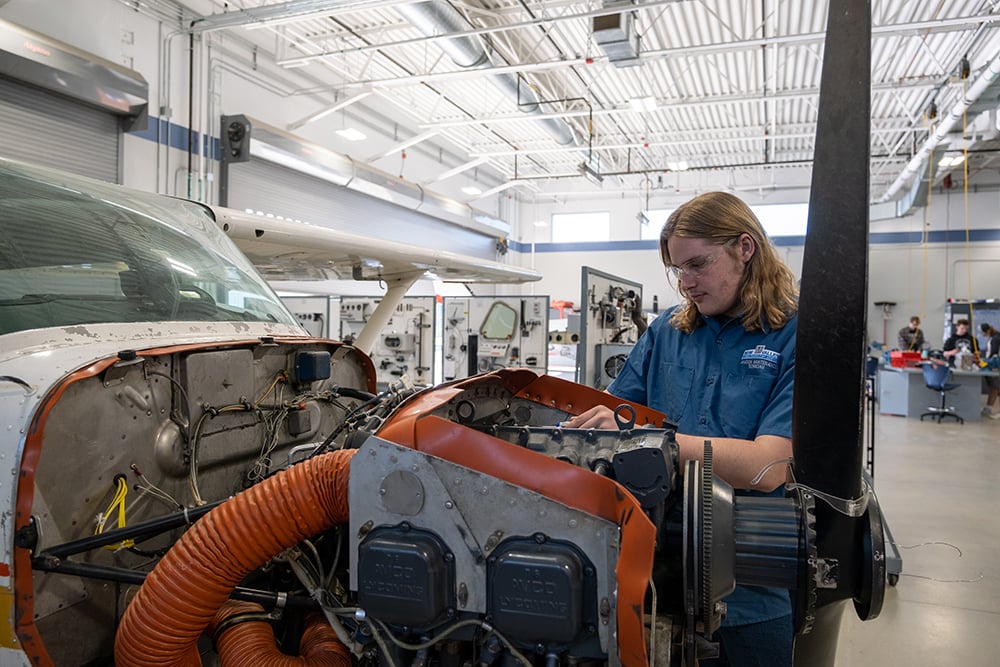
Ryan Bruss (left) and Jarrett Walters (right) returned to their alma mater after careers in the MRO industry to teach future aviation maintenance technicians.
Former students have now become the teachers at a unique school in Ohio, which is graduating high school students with the triple-threat combo of high school diplomas, airframe and powerplant licenses, and associate college degrees.
Located in Englewood, Ohio, Miami Valley Career Technology Center (MVCTC) offers 43 career-technical programs—including an aviation maintenance technician (AMT) program—for juniors and seniors at 27 area high schools. During the two-year program, students spend half the day at MVCTC learning airframe and powerplant (A&P) curriculum and the other half of the day taking their normal high school course load. In some cases, students who qualify can earn college credit in certain academic courses through MVCTC’s partner schools. Since the program is funded by the state, students can obtain all three certifications for less than $600.

Ryan Bruss and Jarrett Walters, both graduates of the program, are now aviation maintenance instructors at MVCTC. “About 20 years ago, when we would make jokes and pull shenanigans [much to their instructors’ chagrin], we’d say to each other, ‘That’s going to be us one day,’” says Walters. “We both went and worked in the industry—Ryan worked in the general aviation side, and I worked in the airline side. Then an opportunity came up and Ryan was able to get in here, and I was just waiting my turn.”
Bruss says the work-life balance of moving to the Part 147 world was a major draw in changing careers. “One thing that drove me to it is, at the time, I had a job where I traveled a lot. I had two young kids at home while working weekends and evenings,” he says. “This job opened up and the pay was slightly less, but my schedule opened up tremendously—very few weekends, no evenings and decent time off in the summer. The pay has caught up, so I can’t complain.”
During the first semester of MVCTC’s AMT program, students learn general aviation curriculum such as how to use tools, read technical documents and drawings, operate safely around aircraft and work with basic systems. Students then take general written tests and move on to the airframe section of their studies during the second semester. Airframe studies are completed by the end of first semester students’ senior year, and they have their airframe license by Christmas.
“As soon as they get that airframe, companies are trying to hire them,” says Bruss. “They’re offering them signing bonuses when they’re 6-8 months from graduation and [before they] have their powerplant. For an 18-year-old, $5,000 [for a signing bonus] is a boatload of money.”
The last semester is spent on powerplant curriculum, such as oil systems, cooling systems and turbine engines. “The goal is by graduation, they’ve got their certification of completion from us done, they’re ready to take their powerplant written test, schedule their own practical and be out of here with a job,” says Bruss.

There is no shortage of companies eager to hire MVCTC’s AMT graduates. Bruss says local partners such as PSA Airlines and Air Wisconsin Airlines frequently hire graduates, and MVCTC was recently selected as a partner school by Delta Air Lines. “Companies are more than willing to stop in [to MVCTC]. They’d be here once a week if we’d let them,” jokes Bruss. “They’ll do anything they can to talk to these students. The pay and bonuses they’re offering, even to these kids who are 18 with zero experience, is pretty unbelievable.”
Students recently took a field trip to Airborne Maintenance & Engineering Services in Wilmington, Ohio, which Walters says is part of the school’s efforts to demonstrate potential career opportunities. “Companies are struggling to get mechanics in the door, but we hope that bringing our students around and showing them the different environments they could possibly work in provides an opportunity for them to see what’s out there.”
Bruss points out how different the hiring environment is now compared to when he and Walters entered the industry. “Sept. 11 had just happened and airlines took a plunge. I actually left [the industry] for a bit and worked at a car dealership before I was able to get into a shop. It’s changed tremendously,” he says. “We’ve even felt it since COVID happened and [the airlines] offered some of these people who were close to retirement big buyouts. The people who were set to retire in the next 4-5 years are now gone and we need more people. I tell these kids, ‘You get this license and I can get you a job. Tell me where you want to go.’ I follow [graduates] on Facebook and they’re all over the country.”

Although around 20-25% of MVCTC’s current AMT students are young women, Walter says he would like to increase gender diversity even further. Bruss adds that some of the program’s best students are women, including a student who recently won Ohio’s SkillsUSA competition and will be traveling to the championships in June.
MVCTC students have access to a variety of aircraft and training equipment, including a Cessna 172, Piper PA-34 Seneca, Piper PA-18 Super Cub and lots of engines. However, Bruss notes that industry support in the form of equipment and manuals would make a huge difference for students. “To get a subscription to one of the major companies that supply manuals is several thousand dollars a year. Plus, we need licenses for each student so more than one kid can use it at a time, and it would just blow our budget every year,” he says.
Students selected for MVCTC’s AMT program are required to be on track to graduate high school. At present, it can accommodate 25 juniors and 25 seniors each year.
You can read other interesting AMT career pathway stories from Aviation Week Network's 2024 Aviation Maintenance Technician Day feature here.





